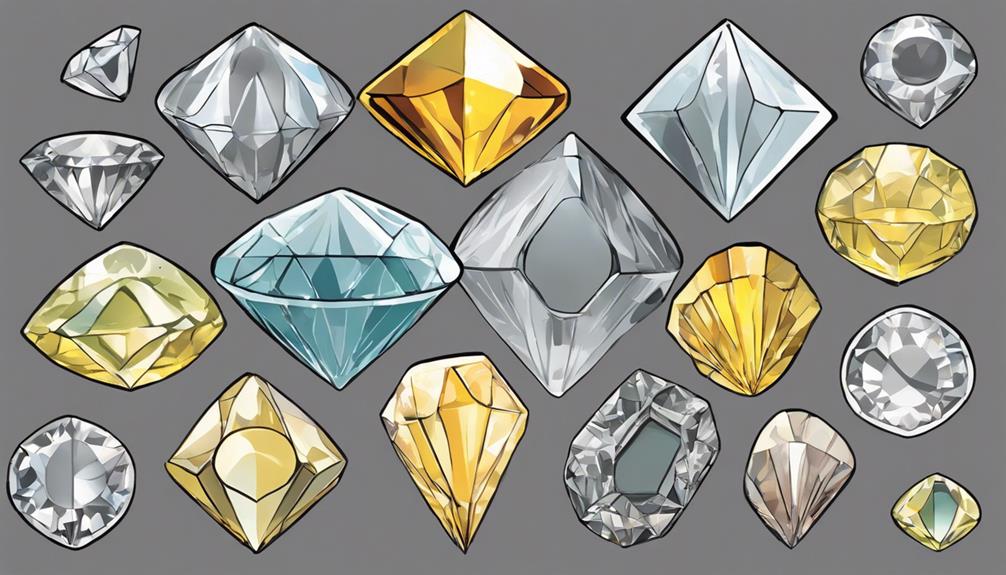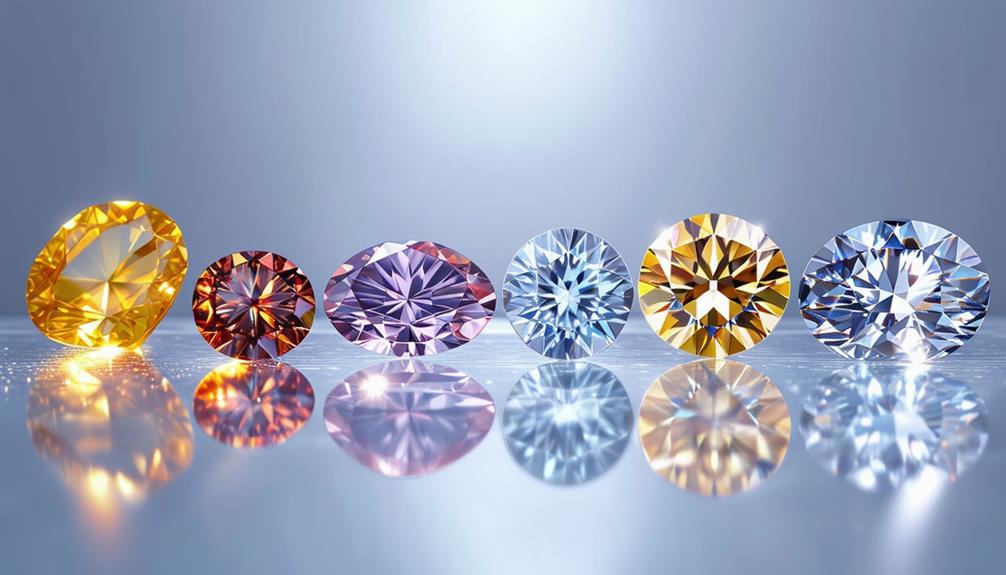Article Contents
Lab-grown diamonds, while similar in essence, vary significantly in quality based on the synthesis methods used: High Pressure High Temperature (HPHT) and Chemical Vapor Deposition (CVD).
Each method affects the diamond's characteristics such as colour and clarity. HPHT diamonds may display blue or grey tinges, whereas CVD diamonds can appear with brown or grey hues.
The value and beauty of these diamonds are also influenced by their cut and clarity, and it is important that they are certified to ensure they meet high standards.
Thus, while lab-grown diamonds share some common traits, their individual qualities can differ greatly.
Key Points
- The synthesis method impacts the appearance of lab-grown diamonds: diamonds produced via High Pressure High Temperature (HPHT) often have blue or grey tinges, whereas those created through Chemical Vapor Deposition (CVD) might exhibit brown or grey tones.
- The quality metrics like cut and clarity of lab-grown diamonds vary based on the precision of the manufacturing process and the conditions under which they are created.
- The synthesis techniques, HPHT and CVD, influence not only the cost but also the physical characteristics of lab-grown diamonds, affecting their market value and application.
- Authenticity and quality of lab-grown diamonds are certified by recognised institutions such as the International Gemological Institute (IGI) or the Gemological Institute of America (GIA), which helps ensure their reliability.
- The selection of colour, clarity, and cut in lab-grown diamonds determines their appropriateness for various types of jewellery and personal taste preferences.
Understanding Diamond Synthesis
Lab-grown diamonds are created using two primary methods: High Pressure High Temperature (HPHT) and Chemical Vapor Deposition (CVD). These methods reflect significant advances in gemmological science, aiming for precision in diamond growth and consistency in quality. In laboratory settings, rigorous attention to detail ensures that each diamond meets high standards of brilliance and structural integrity, sought after by both experts and luxury consumers.
The field of synthetic diamonds benefits from ongoing research that continuously improves the synthesis processes. By closely simulating the natural conditions in which diamonds form, yet enhancing control to reduce impurities and increase clarity, scientists and gemmologists are able to produce diamonds that often exceed the quality of natural ones. This achievement showcases human innovation and the capability to advance traditional practices.
As technology progresses, the meticulous creation of diamonds through HPHT and CVD exemplifies how modern techniques can maintain the enchantment of diamonds, while supporting ethical and sustainable practices in the industry. This evolution in diamond synthesis not only adheres to but advances the standards of gem quality and ethical production.
CVD Versus HPHT Methods
When evaluating the CVD and HPHT methods for diamond synthesis, each method offers distinct benefits and affects production efficiency and costs differently. The Chemical Vapour Deposition (CVD) method uses a chamber where carbon-rich gases are introduced onto a seed crystal, allowing diamonds to grow layer by layer. This approach is noted for its cost-efficiency, primarily because it operates at lower pressures than its counterpart.
Conversely, the High Pressure High Temperature (HPHT) method mimics the natural conditions in which diamonds form beneath the Earth's surface, applying high pressure and temperature to convert carbon into crystalline diamond around a seed crystal. This older technique typically incurs higher manufacturing costs due to the substantial energy required to sustain such extreme conditions.
Both techniques produce high-quality diamonds, but a thorough analysis indicates that CVD tends to be more cost-effective. This knowledge is crucial for those considering lab-grown diamonds, especially for individuals who value innovation and economic efficiency. The choice between CVD and HPHT diamonds reflects not only personal taste but also an endorsement of certain technological and economic principles.
Assessing Cut and Clarity
The quality of the cut is crucial for lab-grown diamonds as it determines how the diamond interacts with light, enhancing its visual appeal.
Clarity is also critical, as it involves grading the diamond based on the presence of inclusions which might affect its appearance.
Both cut and clarity are fundamental in assessing the attractiveness and worth of lab-grown diamonds, and they are vital criteria for buyers to consider when choosing a diamond.
Importance of Cut Quality
The precision of a lab-grown diamond's cut is crucial as it significantly affects how the diamond interacts with light, which in turn determines its brilliance, sparkle, and overall aesthetic appeal. A precise cut ensures optimal light reflection within the diamond, enhancing its sparkle, which goes beyond mere brightness. This involves intricate light play within the gem, producing a captivating display of luminance.
| Aspect | Impact |
|---|---|
| Cut Precision | Crucial for maximising visual impact and brilliance |
| Light Interaction | Enhances sparkle through effective reflections |
| Sparkle Enhancement | Increases scintillation and light dispersion |
| Visual Appeal | Boosts attractiveness and value perception |
| Expertise Required | Critical for determining optimal cut quality |
This careful attention to the quality of the cut ensures that each lab-grown diamond realises its maximum potential, symbolising both aesthetic beauty and craftsmanship.
Clarity Grading Standards
Cut quality has a significant impact on how lab-grown diamonds are assessed. The grading of clarity follows strict criteria to spot any imperfections, whether internal or external. This thorough process guarantees that each diamond attains a high level of visual appeal, enhancing its desirability in the market.
- Consistency in Clarity: Ensures an accurate assessment of each diamond, instilling trust in lab-grown options.
- Market Variations: Recognises differences in clarity grading across various producers, which can affect both the diamond's worth and its allure.
- Clarity's Influence on Consumer Decisions: Consumers tend to favour diamonds with superior clarity for their exceptional sparkle, a factor that significantly shapes their purchasing choices.
These insights empower consumers to make informed decisions that mirror their individual values and aesthetic preferences, enabling them to choose diamonds that truly align with their expectations.
Importance of Certification
In the domain of lab-grown diamonds, certification plays a crucial role in confirming the diamonds' authenticity and quality. Organisations like the International Gemological Institute (IGI) and the Gemological Institute of America (GIA) set comprehensive standards, providing detailed assessments that verify both the quality and the origin of these diamonds.
Such certifications include laser inscriptions on the diamonds, crucial for confirming their authenticity. This process helps in building trust among consumers by ensuring that each diamond meets high standards of integrity and quality.
Certification Standards Explained
Certification from esteemed institutions like IGI and GIA is crucial for lab-grown diamonds, as it guarantees the gems meet rigorous quality and authenticity standards. This certification process ensures each diamond adheres to established industry benchmarks before it is available to consumers.
- Transparency in Transactions: Certification documents provide comprehensive details about the diamond, giving consumers the confidence and knowledge to make informed decisions.
- Consistency Across the Industry: Uniform standards ensure that all certified lab-grown diamonds undergo the same rigorous evaluation process.
- Freedom of Choice: Accurate and trustworthy information allows consumers to select diamonds that align with their expectations and ethical values, leading to greater satisfaction.
This approach not only maintains quality and trust in the diamond market but also supports consumer rights by providing clear, reliable information.
Verifying Authenticity and Quality
Recognising the importance of certification is crucial to verify the authenticity and quality of lab-grown diamonds to maintain consumer trust. Certificates issued by reputable gemological institutions such as IGI and GIA provide a reliable quality assurance and origin verification framework. These certificates are comprehensive and confirm that each diamond has been thoroughly evaluated.
Furthermore, laser inscriptions on the diamonds, which include unique identifiers and the 'lab grown' designation as required by IGI standards, ensure the legitimacy and traceability of each stone. Choosing certified lab-grown diamonds guarantees that consumers receive a product that adheres to stringent standards of quality and ethical sourcing.
Comparing Colour Variations

Lab-created diamonds demonstrate a range of colour variations, such as brown, grey, or blue tinges, depending on the method of synthesis used. These variations are crucial when choosing a diamond that matches personal colour preferences and enhances visual appeal. The two main methods, Chemical Vapor Deposition (CVD) and High Pressure High Temperature (HPHT), each impart unique colour characteristics that impact the aesthetics and suitability of diamonds for various jewellery applications.
- CVD-Grown Diamonds: These diamonds typically exhibit brown or grey hues. The subtle yet noticeable colours cater to those looking for a modern, distinctive appearance.
- HPHT-Grown Diamonds: Characterised by blue or grey shades and sometimes showing phosphorescence, these diamonds offer a traditional yet captivating look.
- Colour Impact on Jewellery Selection: The specific colour traits of diamonds influence how well they complement different metal settings and styles, offering flexibility in customising jewellery to suit individual tastes.
For those seeking a particular vibe or connection with their jewellery, understanding these colour differences is crucial for making a meaningful and satisfying choice that aligns with their aesthetic preferences and personal style.
Evaluating Carat and Size
When evaluating lab-grown diamonds, carat weight and size are crucial in determining the diamond's aesthetic appeal and price. Understanding the intricacies of carat weight and size selection is essential for making informed choices that align with personal style and budget.
Lab-grown diamonds are meticulously crafted, allowing precise control over their size and weight. Below is a table that outlines typical variations:
| Carat Weight | Size Description | Typical Use |
|---|---|---|
| 0.25 – 0.5 | Small | Earrings |
| 0.5 – 1.0 | Medium | Engagement Rings |
| 1.0 – 2.0 | Large | Statement Pieces |
This range enables consumers to choose from a subtle quarter carat to a striking two carats. Carat weight significantly affects both the diamond's visual appeal and its cost, facilitating a balance between visual impact and affordability. This flexibility ensures that each buyer can select a lab-grown diamond that truly reflects their personal preferences and values.
Frequently Asked Questions
Are all lab-created diamonds of the same quality?
Lab-grown diamonds vary in quality, influenced by different production methods and the standards of various certification bodies. To guarantee the purchase of a high-quality, ethically produced diamond, it is important to carefully examine the manufacturing processes of the suppliers.
Are there different qualities of lab-grown diamonds?
Lab-grown diamonds vary in quality because of various production techniques, which impact their clarity, colour, and cut. These differences affect their prices, giving consumers the option to choose diamonds that match their preferences and budget.
Do Lab Grown Diamonds Have the Same Properties?
Lab-grown diamonds share the same chemical composition and physical properties as natural diamonds. These diamonds are created through advanced technological processes that replicate the natural diamond-growing conditions, ensuring the production of high-quality gems. This not only provides a sustainable alternative but also allows consumers to choose environmentally friendly options without compromising on quality.
Can you tell the difference between lab-grown diamonds?
Lab-grown diamonds, like snowflakes, each exhibit unique characteristics; variations in colour and crystal imperfections can be discerned. Certifications are crucial as they affirm the quality of these stones, providing buyers with the assurance needed to select distinctive gems that have no exact natural equivalents.
Conclusion
To summarise, lab-grown diamonds, while sustainable, vary in quality. The two primary production methods, CVD (Chemical Vapor Deposition) and HPHT (High Pressure High Temperature), produce diamonds with distinct qualities and potential flaws. Authenticity and quality assurance require strict certification, as these synthetic diamonds can differ in colour, clarity, and cut.
Contrary to popular belief, not all lab-created diamonds are perfect. Therefore, consumers should conduct comprehensive evaluations to ensure they purchase high-quality lab-grown diamonds.

